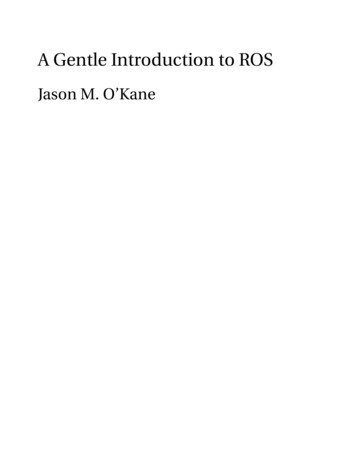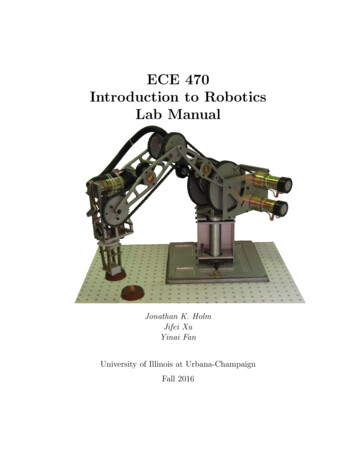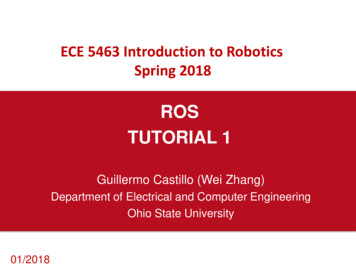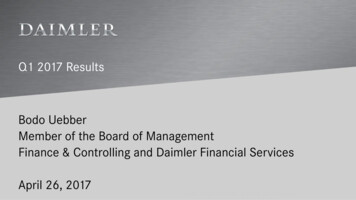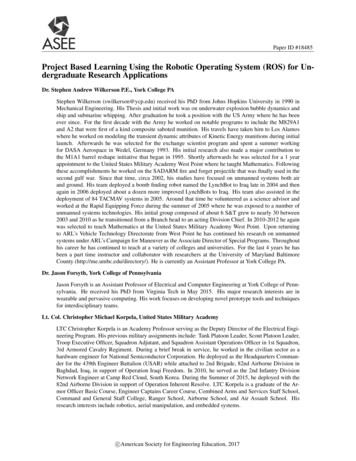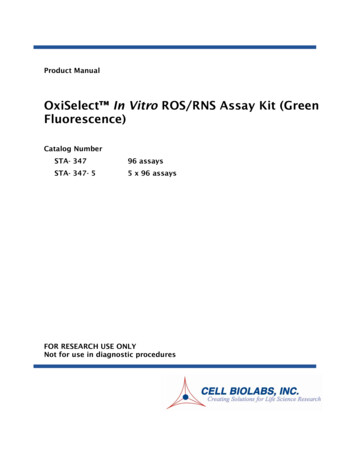
Transcription
Product ManualOxiSelect In Vitro ROS/RNS Assay Kit (GreenFluorescence)Catalog NumberSTA- 34796 assaysSTA- 347- 55 x 96 assaysFOR RESEARCH USE ONLYNot for use in diagnostic procedures
IntroductionReactive oxygen species (ROS) and reactive nitrogen species (RNS) are well-established moleculesresponsible for the deleterious effects of oxidative stress. Accumulation of free radicals coupled withan increase in oxidative stress has been implicated in the pathogenesis of several disease states. Therole of oxidative stress in vascular diseases, diabetes, renal ischemia, atherosclerosis, pulmonarypathological states, inflammatory diseases, cancer, as well as ageing has been well established. Freeradicals and other reactive species are constantly generated in vivo and cause oxidative damage tobiomolecules, a process held in check by the existence of multiple antioxidant and repair systems aswell as the replacement of damaged nucleic acids, proteins and lipids. Measuring the effect ofantioxidant therapies and ROS/RNS activity is crucial to suppressing or treating oxidative stressinducers.The OxiSelect In Vitro ROS/RNS Assay Kit is an assay for measuring the total free radical presenceof a sample. The assay employs a proprietary quenched fluorogenic probe, dichlorodihydrofluorescinDiOxyQ (DCFH-DiOxyQ), which is a specific ROS/RNS probe that is based on similar chemistry tothe popular 2’, 7’-dichlorodihydrofluorescein diacetate. The DCFH-DiOxyQ probe is first primed witha quench removal reagent, and subsequently stabilized in the highly reactive DCFH form. In thisreactive state, ROS and RNS species can react with DCFH, which is rapidly oxidized to the highlyfluorescent 2’, 7’-dichlorodihydrofluorescein (DCF) (Figure 1). Fluorescence intensity is proportionalto the total ROS/RNS levels within the sample. The DCFH-DiOxyQ probe can react with hydrogenperoxide (H2O2), peroxyl radical (ROO·), nitric oxide (NO), and peroxynitrite anion (ONOO-). Thesefree radical molecules are representative of both ROS and RNS, thus allowing for measurement of thetotal free radical population within a sample. OxiSelect In Vitro ROS/RNS Assay Kit can also beused to evaluate antioxidant’s effect on free radicals. The kit has a detection sensitivity limit of 10 pMfor DCF and 40 nM for H2O2 respectively. Each kit provides sufficient reagents to perform up to 96assays, including standard curve and unknown samples.Assay PrincipleThe OxiSelect In Vitro ROS/RNS Assay Kit is an in vitro assay for measuring total ROS/RNS freeradical activity. Unknown ROS or RNS samples or standards are added to the wells with a catalystthat helps accelerate the oxidative reaction. After a brief incubation, the prepared DCFH probe isadded to all wells and the oxidation reaction is allowed to proceed (Figure 1). Samples are measuredfluorometrically against a hydrogen peroxide or DCF standard. The assay is performed in a 96-wellfluorescence plate format that can be read on a standard fluorescence plate reader. The free radicalcontent in unknown samples is determined by comparison with the predetermined DCF or hydrogenperoxide standard curve.2
Figure 1. Mechanism of In Vitro ROS/RNS Assay.Related Products1. STA-330: OxiSelect TBARS Assay Kit (MDA Quantitation)2. STA-340: OxiSelect Superoxide Dismutase Activity Assay3. STA-341: OxiSelect Catalase Activity Assay Kit4. STA-342: OxiSelect Intracellular ROS Assay Kit (Green Fluorescence)3
5. STA-832: OxiSelect MDA Adduct Competitive ELISA Kit6. STA-838: OxiSelect HNE Adduct Competitive ELISA KitKit Components1. Priming Reagent (Part No. 234701): One 250 µL tube of solution.2. Stabilization Solution (10X) (Part No. 234702): One 1.5 mL tube of solution.3. Catalyst (250X) (Part No. 234703): One 20 µL tube of solution.4. DCF-DiOxyQ (Part No. 234704): One 50 µL amber tube of solution in methanol.5. DCF Standard (Part No. 234202): One 100 µL amber tube of a 1 mM solution in DMSO.6. Hydrogen Peroxide (Part No. 234102): One 100 µL amber tube of an 8.821 M solution.Materials Not Supplied1. 10 µL to 1000 µL adjustable single channel micropipettes with disposable tips2. 50 µL to 300 µL adjustable multichannel micropipette with disposable tips3. Multichannel micropipette reservoir4. Phosphate Buffered Saline for sample preparations and dilutions5. 96-well black or fluorescence microtiter plate6. Fluorescent microplate reader capable of reading 480 nm (excitation) and 530 nm (emission)StorageUpon receipt, store the DCF-DiOxyQ and DCF Standard at -20ºC. Avoid multiple freeze/thaw cycles.Store all other components at 4ºC.Preparation of Reagents 1X Stabilization Solution: Dilute the 10X Stabilization Solution 1:10 by adding 1.5 mL of solutionto 13.5 mL of deionized water. Stir or vortex to homogeneity. Store the solution at 4ºC. 1X Catalyst: Prior to use, dilute the 250X Catalyst 1:250 in PBS. Vortex thoroughly. Prepareonly enough for immediate applications (eg. add 10 µL of Catalyst to 2.49 mL PBS for 50 wells). DCFH Solution: Prepare only enough DCFH Solution for immediate applications in an amber tubeor aluminum foil covered tube. Prepare DCFH Solution by diluting the stock solution of DCFDiOxyQ 1:5 with Priming Reagent (eg. for 50 assays, add 25 µL DCF-DiOxyQ to 100 µL PrimingReagent). Vortex to homogeneity. Incubate the solution for 30 minutes at room temperature.Next, dilute the reaction 1:40 with 1X Stabilization Solution (eg. for 50 assays, add 125 µL DCFDiOxyQ/ Priming Reagent reaction to 4.875 mL of Stabilization Solution). Vortex tohomogeneity. Protect the solution from light. This solution is now stable in the DCFH form andready to use. The solution may be stored at -20ºC for up to one week when protected from light.Note: Due to light-induced auto-oxidation, the stock DCF-DiOxyQ solution and all subsequentDCF-DiOxy and DCFH solutions must be protected from light.4
Preparation of SamplesAll samples should be assayed immediately or stored at -80 C for up to 1-2 months. The assay may beused on cell or tissue lysates, cell culture supernatants, serum, plasma, urine, and other biologicalfluids. Always run a standard curve with samples. Use PBS for dilution and preparation of samples.Some common detergents and denaturants have been tested for compatibility in the assay (belowtable). Dilution of samples, and interfering substances, may be necessary for assay compatibility.SubstanceTriton ompatible Concentration 1% 1% 0.1% 1% 0.1% 10 mM 10 mM 10%Table 1. Substance Compatibility Table Cells or Tissues: Resuspend cells at 1-2 x 107 cells/mL or tissues at 10-50 mg/mL in PBS.Homogenize or sonicate on ice. To remove insoluble particles, spin at 10,000 g for 5 min. Thehomogenate can be assayed directly or stored at -80ºC as necessary.Serum, Plasma, Urine or Cell Culture Supernatants: To remove insoluble particles, spin at 10,000 gfor 5 min. The supernatant can be assayed directly or stored at -80 C as necessary.Preparation of the DCF Standard Curve1. Prepare a 1:10 dilution series of DCF standards in the concentration range of 0 µM – 10 µM bydiluting the 1mM DCF stock in 1X PBS (see Table 2).StandardTubes123456DCF Standard(µL)10100 of Tube #1100 of Tube #2100 of Tube #3100 of Tube #40PBS(µL)9909009009009001000Table 2. Preparation of DCF Standards5DCF(nM)10,00010001001010
2. Transfer 200 µL of each DCF standard to a 96-well plate suitable for fluorescence measurement.3. Read the relative fluorescence with a fluorescence plate reader at 480 nm excitation / 530 nmemission.Preparation of the H2O2 Standard Curve1. To prepare the Hydrogen Peroxide standards, first perform a 1:4400 dilution of the stock HydrogenPeroxide in deionized water. Use only enough for immediate applications (eg. Add 5 μL ofHydrogen Peroxide to 22 mL deionized water). This solution has a concentration of 2 mM.2. Use the 2 mM H2O2 solution to prepare standards in the concentration range of 0 µM – 20 µM byfurther diluting in PBS (see Table 3). H2O2 diluted solutions and standards should be preparedfresh. Use the table below as a reference guide only. The volumes and concentrations of thestandard may be adjusted by the user.StandardTubes12345678910112 mM H2O2 Standard(µL)10500 of Tube #1500 of Tube #2500 of Tube #3500 of Tube #4500 of Tube #5500 of Tube #6500 of Tube #7500 of Tube #8500 of Tube #90PBS (µL)9905005005005005005005005005001000H2O2 (µM)201052.51.250.6250.3130.1560.0780.0390Table 3. Preparation of H2O2 StandardsAssay Protocol1. Prepare and mix all reagents thoroughly before use. Each sample, including unknown(s) andstandard(s), should be assayed in duplicate or triplicate.2. Add 50 µL of unknown sample or hydrogen peroxide standard to wells of a 96-well plate suitablefor fluorescence measurement.3. Add 50 µL of Catalyst to each well. Mix well and incubate 5 minutes at room temperature.4. Add 100 µL of DCFH solution to each well. Cover the plate reaction wells to protect them fromlight and incubate at room temperature for 15-45 minutes.5. Read the fluorescence with a fluorescence plate reader at 480 nm excitation / 530 nm emission.Example of ResultsThe following figures demonstrate typical Free Radical ROS/RNS Assay results. Fluorescencemeasurement was performed on SpectraMax Gemini XS Fluorometer (Molecular Devices) with a6
485/538 nm filter set and 530 nm cutoff. One should use the data below for reference only. This datashould not be used to interpret actual results.Figure 2. DCF Standard Curve.Figure 3. Hydrogen Peroxide Standard Curve.7
Figure 4. Detection of various free radical species using OxiSelect In Vitro ROS/RNS AssayKit. DCF Fluorescence curves for AAPH (peroxyl radical generator, top), SIN-1 (peroxynitritegenerator, center), and SNP (nitric oxide generator, bottom).8
References1. Bass DA, Parce JW, Dechatelet LR, Szejda P, Seeds MC, Thomas M. Flow cytometric studies ofoxidative product formation by neutrophils: A graded response to membrane stimulation. JImmunol. 1983; 130:1910-1917.2. Brandt R, Keston AS. Synthesis of diacetyldichlorofluorescin: A stable reagent for fluorometricanalysis. Anal Biochem. 1965; 11:6-9.3. Keston AS, Brandt R. The fluorometric analysis of ultramicro quantities of hydrogen peroxide.Anal Biochem.1965; 11:1-5.Recent Product Citations1. Sweeney, S. et al. (2017). Biocompatibility of Multi-Imaging Engineered Mesoporous SilicaNanoparticles: In Vitro and Adult and Fetal In Vivo Studies. J. Biomed. Nanotech. 13:544-558.2. Wang, H. et al. (2017). The metabolic function of cyclin D3-CDK6 kinase in cancer cell survival.Nature 546:426-430.3. Franklin, M.P. et al. (2017). Acyl-CoA Thioesterase 1 (ACOT1) regulates PPARα to couple fattyacid flux with oxidative capacity during fasting. Diabetes doi:10.2337/db16-1519.4. Miao, H.H. et al. (2017). Ginsenoside Rb1 attenuates isoflurane/surgery-induced cognitivedysfunction via inhibiting neuroinflammation and oxidative stress. Biomed Environ Sci. 30(5):363372.5. Kuete, V. et al. (2017). Cytotoxicity of the methanol extracts of Elephantopus mollis, Kalanchoecrenata and 4 other Cameroonian medicinal plants towards human carcinoma cells. BMCComplement Altern Med. 17(1):280.6. Park, S.Y. et al. (2017). Standardized Mori ramulus extract improves insulin secretion and insulinsensitivity in C57BLKS/J db/db mice and INS-1 cells. Biomed Pharmacother. 92:308-315.7. Cheng, Z. et al. (2017). Rejuvenation of cardiac tissue developed from reprogrammed aged somaticcells. Rejuvenation Res. doi:10.1089/rej.2017.1930.8. Hong, M. et al. (2017). Ethanol itself is a holoprosencephaly-inducing teratogen. PLoS One 12(4):e0176440.9. McLaughlin, J.P. et al. (2017). Conditional Human Immunodeficiency Virus transactivator oftranscription protein expression induces depression-like effects and oxidative stress. Biol. Psych.:Cogn. Neurosci. Neuroimaging doi:10.1016/j.bpsc.2017.04.002.10. Younan, P., et al. (2017). The Toll-Like Receptor 4 Antagonist Eritoran Protects Mice from LethalFilovirus Challenge. MBio. 8(2). pii: e00226-17. doi: 10.1128/mBio.00226-17.11. Wang, L., et al. (2017). Activation of hypoxia-inducible factor-1α by prolonged in vivohyperinsulinemia treatment potentiates cancerous progression in estrogen receptor-positive breastcancer cells. Biochem Biophys Res Commun. pii: S0006-291X(17)30604-6. doi:10.1016/j.bbrc.2017.03.12812. Li, C., et al. (2017). Hydrogen-rich saline attenuates isoflurane-induced caspase-3 activation andcognitive impairment via inhibition of isoflurane-induced oxidative stress, mitochondrialdysfunction, and reduction in ATP levels. Am J Transl Res. 9(3):1162-1172. eCollection 2017.13. Sodhi, K. et al. (2017). pNaKtide Attenuates Steatohepatitis and Atherosclerosis by BlockingNa/K-ATPase/ROS Amplification in C57Bl6 and ApoE Knockout Mice Fed a Western Diet. SciRep. 7(1):193. doi: 10.1038/s41598-017-00306-5.14. Qin, X. et al. (2017). Co-expression of growth differentiation factor 11 and reactive oxygen speciesin metastatic oral cancer and its role in inducing the epithelial to mesenchymal transition. OralSurgery, Oral Medicine, Oral Pathology and Oral Radiology.9
15. Alagbonsi, I.A. (2017). Role of oxidative stress in Cannabis sativa-associated spermatotoxicity:Evidence for ameliorative effect of combined but not separate melatonin and vitamin C. MiddleEast Fertility Society Journal. http://dx.doi.org/10.1016/j.mefs16. Ali NM, et al. (2017). Synthetic curcumin derivative DK1 possessed G2/M arrest and inducedapoptosis through accumulation of intracellular ROS in MCF-7 breast cancer cells. Cancer CellInt. 17:30. doi: 10.1186/s12935-017-0400-3.17. Cazzola, M., et al. (2017). Bioactive glasses functionalized with polyphenols: in vitro interactionswith healthy and cancerous osteoblast cells. J Mater Sci. doi:10.1007/s10853-017-0872-518. Cho YE, et al. (2017). Neuronal Cell Death and Degeneration through Increased NitroxidativeStress and Tau Phosphorylation in HIV-1 Transgenic Rats. PLoS One. 12(1):e0169945. doi:10.1371/journal.pone.0169945.19. Lee KH, et al. (2017). Enhanced-autophagy by exenatide mitigates doxorubicin-inducedcardiotoxicity. Int J Cardiol. 232:40-47. doi: 10.1016/j.ijcard.2017.01.123.20. Liu H, et al. (2017). Impact of Dehydroepiandrosterone Sulfate on Newborn Leukocyte TelomereLength. Sci Rep. 7:42160. doi: 10.1038/srep42160.21. Roche JR, et al. (2017). Strategies to gain body condition score in pasture-based dairy cows duringlate lactation and the far-off nonlactating period and their interaction with close-up dry matterintake. J Dairy Sci. 100(3):1720-1738. doi: 10.3168/jds.2016-11591.22. Soni, D., et al. (2017). Oxidative Stress and Genotoxicity of Zinc Oxide Nanoparticlesto Pseudomonas Species, Human Promyelocytic Leukemic (HL-60), and Blood Cells. Biol TraceElem Res. doi:10.1007/s12011-016-0921-y23. Tsai CY, et al. (2017). Nitrosative Stress-Induced Disruption of Baroreflex Neural Circuits in a RatModel of Hepatic Encephalopathy: A DTI Study. Sci Rep. 7:40111. doi: 10.1038/srep40111.24. Zhelev, Z. et al. (2017). Synergistic cytotoxicity of melatonin and new-generation anticancer drugsagainst leukemia lymphocytes but not normal lymphocytes. Anticancer Res. 37:149-159.Please see the complete list of product citations: WarrantyThese products are warranted to perform as described in their labeling and in Cell Biolabs literature when used inaccordance with their instructions. THERE ARE NO WARRANTIES THAT EXTEND BEYOND THIS EXPRESSEDWARRANTY AND CELL BIOLABS DISCLAIMS ANY IMPLIED WARRANTY OF MERCHANTABILITY ORWARRANTY OF FITNESS FOR PARTICULAR PURPOSE. CELL BIOLABS’ sole obligation and purchaser’sexclusive remedy for breach of this warranty shall be, at the option of CELL BIOLABS, to repair or replace the products.In no event shall CELL BIOLABS be liable for any proximate, incidental or consequential damages in connection with theproducts.Contact InformationCell Biolabs, Inc.7758 Arjons DriveSan Diego, CA 92126Worldwide: 1 858-271-6500USA Toll-Free: 1-888-CBL-0505E-mail: tech@cellbiolabs.comwww.cellbiolabs.com 2010-2017: Cell Biolabs, Inc. - All rights reserved. No part of these works may be reproduced in any form withoutpermissions in writing.10
2. Transfer 200 µL of each DCF standard to a 96-well plate suitable for fluorescence measurement. 3. Read the relative fluorescence with a fluorescence plate reader at 480 nm excitation / 530 nm emission. 1. To prepare the Hydrogen Peroxide standards, first perform a 1:4400 dilution of the stock Hydrogen Peroxide in deionized water.




